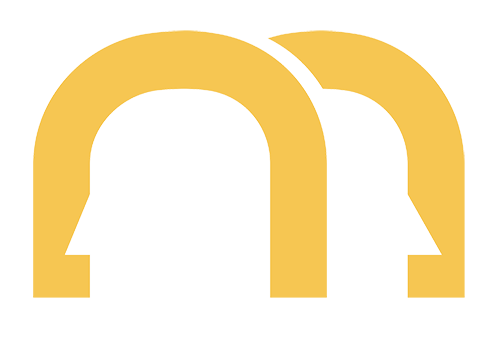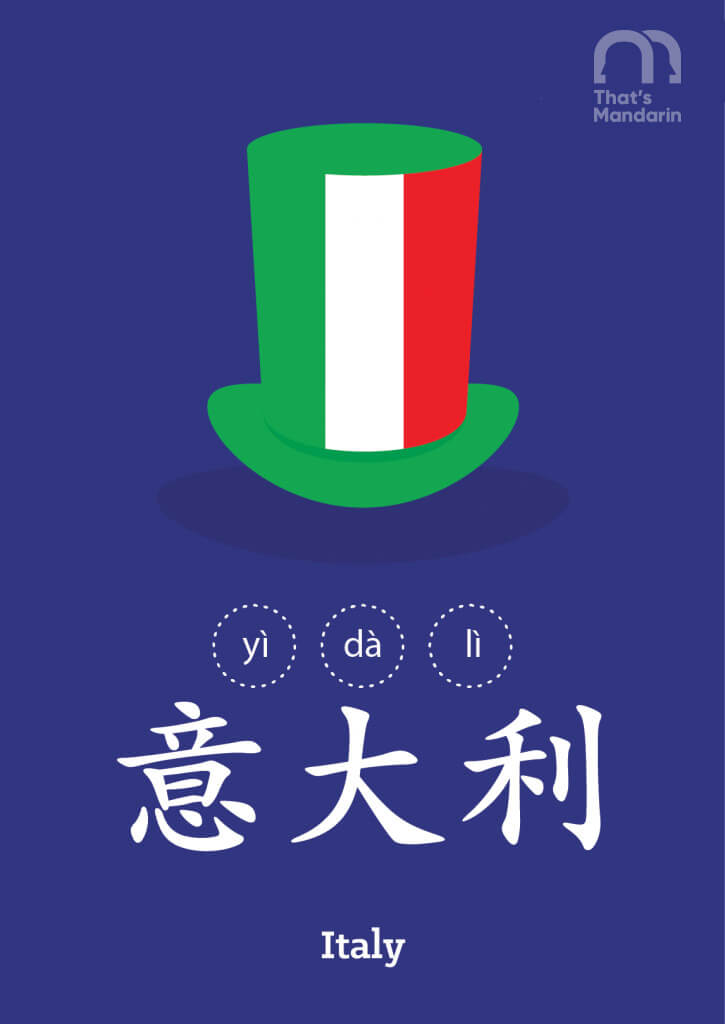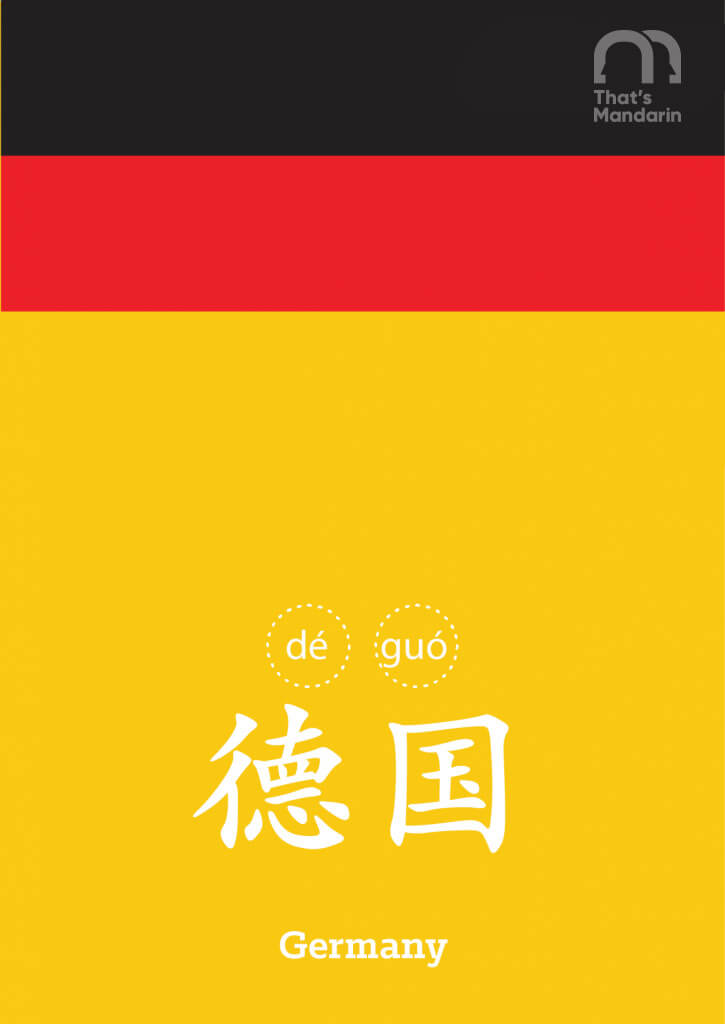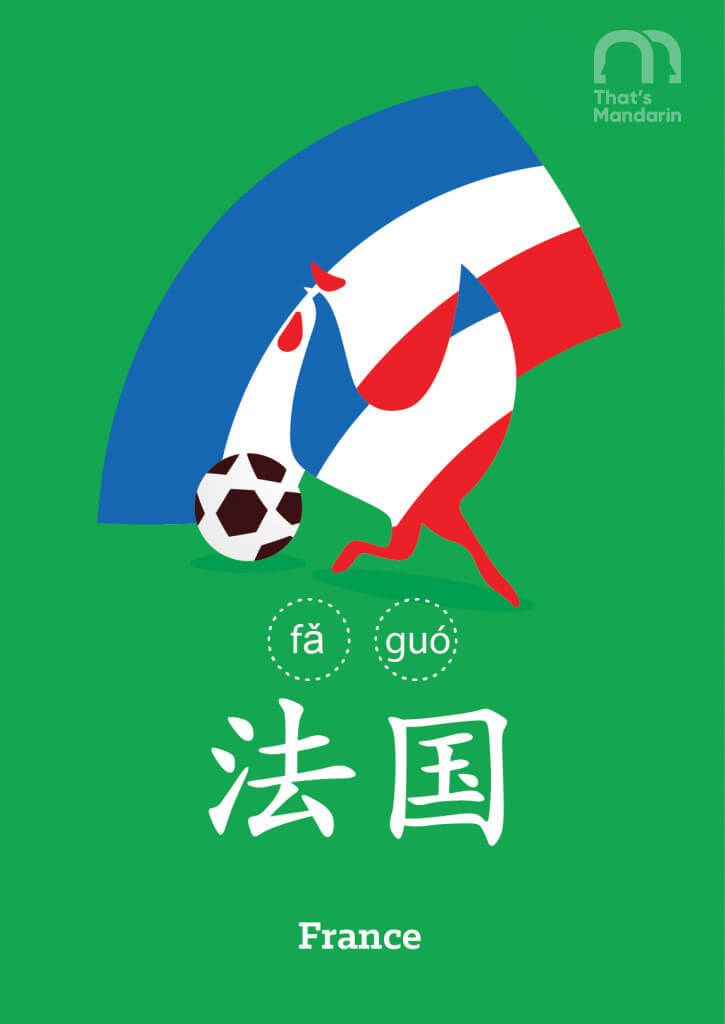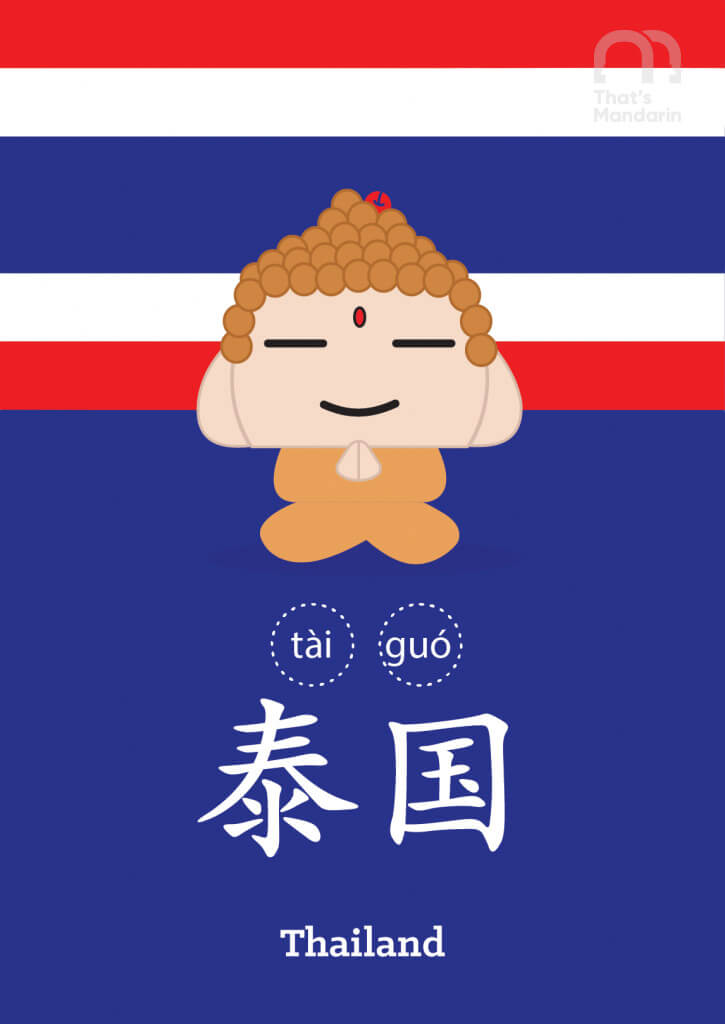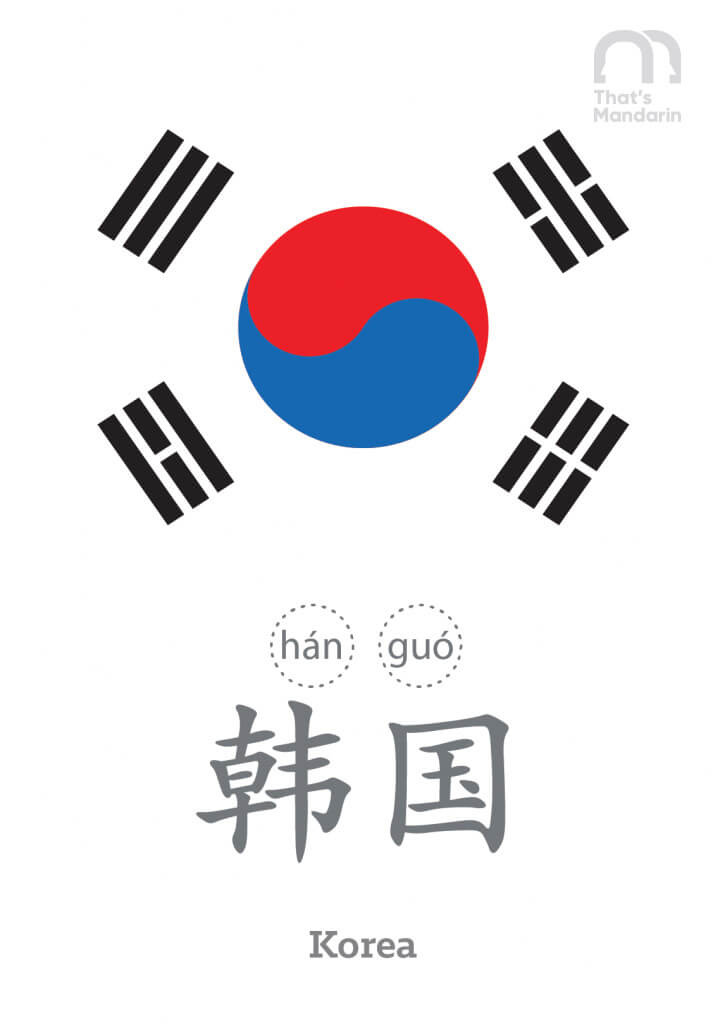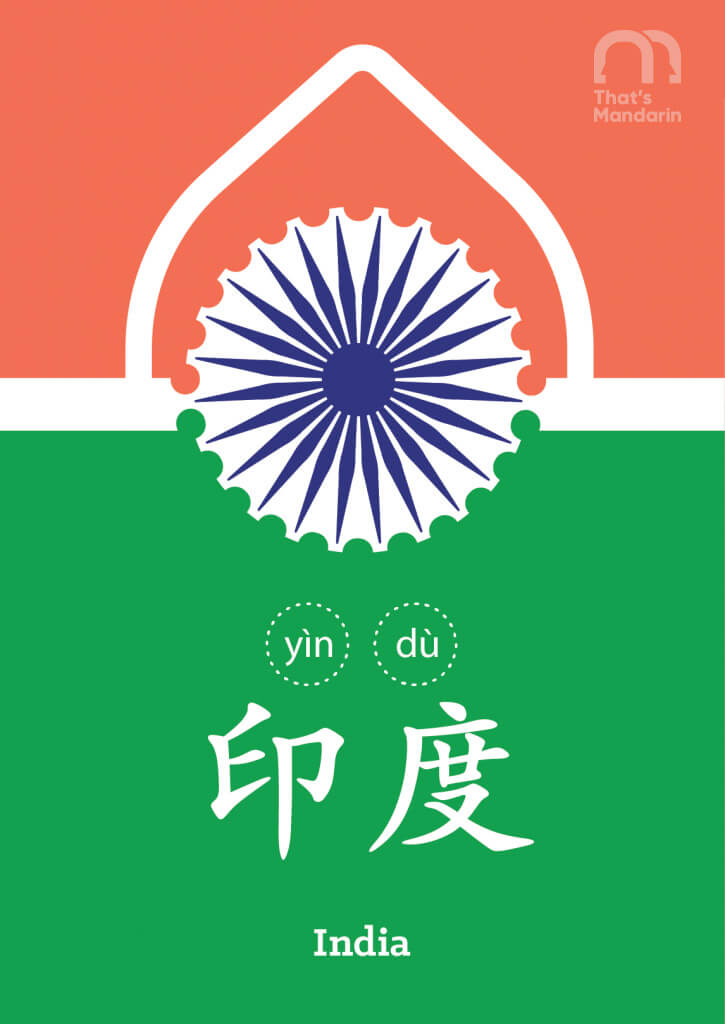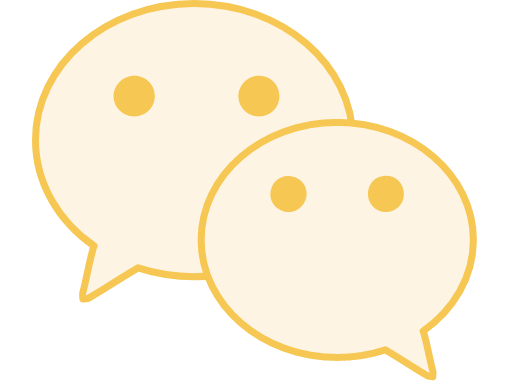Chinese Link Words: Country Names in Chinese
Italy | 意大利 (Yìdàlì)
Italy is called 意大利 (Yìdàlì) in Chinese. It sounds exactly like its English pronunciation. Speaking about Italy and China, the first person that comes into your mind must be Marco Polo!! He’s famous for his great adventure in the east, but what did he actually do in China. Let’s find out today.
At the age of seventeen, Marco set off on a voyage to Asia with his father and his uncle. The distance they traveled was almost 15,000 miles (24,000 km)!! You can check out the route he took on the map. He later documented this voyage in his book “The Travels of Marco Polo” (马可波罗游记, Mǎkě Bōluó Yóujì).
The book starts with a preface describing the travels of Marco’s father and uncle. In 1266, Marco’s father and his uncle reached Beijing. There they met Kublai Khan, a Mongol ruler and founder of the Yuan Dynasty. Mongolians were ruling China at the time. Kublai received the brothers with hospitality. Kublai requested the brothers bring back some souvenirs from Europe.
In 1271, Marco, his father and uncle set off on their voyage to fulfill Kublai’s request. Three and a half years after leaving Venice, when Marco was about 21 years old, they finally reached the Kublai’s summer palace.
Marco knew four languages, and the Polo family had a great deal of knowledge and experience that was useful to Kublai. It is possible that he became a government official. He wrote about many imperial visits to China’s southern and eastern provinces, the far south and Burma.
After a 24-year voyage, he was able to go back to Venice eventually. In his book, he praised China highly, which made Europeans all look forward to visit China. But some other people argue that there are many inventions and exaggerations in his book. Anyway, the book was one of the most detailed materials provided for westerns to learn about the eastern world.
Italy | 意大利 (Yìdàlì)
Italy is called 意大利 (Yìdàlì) in Chinese. It sounds exactly like its English pronunciation. Speaking about Italy and China, the first person that comes into your mind must be Marco Polo!! He’s famous for his great adventure in the east, but what did he actually do in China. Let’s find out today.
At the age of seventeen, Marco set off on a voyage to Asia with his father and his uncle. The distance they traveled was almost 15,000 miles (24,000 km)!! You can check out the route he took on the map. He later documented this voyage in his book “The Travels of Marco Polo” (马可波罗游记, Mǎkě Bōluó Yóujì).
The book starts with a preface describing the travels of Marco’s father and uncle. In 1266, Marco’s father and his uncle reached Beijing. There they met Kublai Khan, a Mongol ruler and founder of the Yuan Dynasty. Mongolians were ruling China at the time. Kublai received the brothers with hospitality. Kublai requested the brothers bring back some souvenirs from Europe.
In 1271, Marco, his father and uncle set off on their voyage to fulfill Kublai’s request. Three and a half years after leaving Venice, when Marco was about 21 years old, they finally reached the Kublai’s summer palace.
Marco knew four languages, and the Polo family had a great deal of knowledge and experience that was useful to Kublai. It is possible that he became a government official. He wrote about many imperial visits to China’s southern and eastern provinces, the far south and Burma.
After a 24-year voyage, he was able to go back to Venice eventually. In his book, he praised China highly, which made Europeans all look forward to visit China. But some other people argue that there are many inventions and exaggerations in his book. Anyway, the book was one of the most detailed materials provided for westerns to learn about the eastern world.
Germany | 德国 (Déguó)
德国 (Déguó) doesn’t come from the name “Germany”, but from “Deutschland”. We selected the first syllable “De” and found a character “德 (dé) which has a similar pronunciation; then we placed 国 (guó) behind it.
Again, Chinese people chose the word with the best meaning for Deutsch. 德 (dé) means “moral” – from 道德 (dàodé) – in Chinese. So you can regard 德国 (Déguó) as a country of morals.
Let’s meet a Geologist who is presumably the person that travelled to most places in China.
Richthofen was born in Carlsruhe, Prussian Silesia, and was educated in Breslau and Berlin. He traveled or studied in the Alps of Tyrol and the Carpathians in Transylvania.
In 1868, Richthofen received the support of the Bank of California and carefully designed seven routes of his geological survey and then came to China. In November 1868, he started travelling around China. During 7 trips, he travelled 18 provinces in China, far more than any Chinese at that time. (Maybe you are the one who can break his record.)
During the trips, he inspected the coal mines in 山西 (Shānxī) and 陕西 (Shǎnxī) carefully. He wrote a letter that China is the country with most coal and the coal in 山西 (Shānxī) could supply coal to the whole world for thousands of years.
When he was travelling in 洛阳 (Luòyáng) of 河南 (Hénán) province, he inspected the history of the silk market and discovered an ancient business route from洛阳 (Luòyáng) to Central Asia. He gave it a name – “The Silk Road”, or 丝绸之路 (Sīchóu Zhī Lù).
After these trips, he came back to Germany and spent the rest of his life arranging his notes from the trips which later became a great book. Its name is “China: Ergebnisse eigener Reisen und darauf gegründeter Studien”.
That’s the story of Richthofen and his country.
Germany | 德国 (Déguó)
德国 (Déguó) doesn’t come from the name “Germany”, but from “Deutschland”. We selected the first syllable “De” and found a character “德 (dé) which has a similar pronunciation; then we placed 国 (guó) behind it.
Again, Chinese people chose the word with the best meaning for Deutsch. 德 (dé) means “moral” – from 道德 (dàodé) – in Chinese. So you can regard 德国 (Déguó) as a country of morals.
Let’s meet a Geologist who is presumably the person that travelled to most places in China.
Richthofen was born in Carlsruhe, Prussian Silesia, and was educated in Breslau and Berlin. He traveled or studied in the Alps of Tyrol and the Carpathians in Transylvania.
In 1868, Richthofen received the support of the Bank of California and carefully designed seven routes of his geological survey and then came to China. In November 1868, he started travelling around China. During 7 trips, he travelled 18 provinces in China, far more than any Chinese at that time. (Maybe you are the one who can break his record.)
During the trips, he inspected the coal mines in 山西 (Shānxī) and 陕西 (Shǎnxī) carefully. He wrote a letter that China is the country with most coal and the coal in 山西 (Shānxī) could supply coal to the whole world for thousands of years.
When he was travelling in 洛阳 (Luòyáng) of 河南 (Hénán) province, he inspected the history of the silk market and discovered an ancient business route from洛阳 (Luòyáng) to Central Asia. He gave it a name – “The Silk Road”, or 丝绸之路 (Sīchóu Zhī Lù).
After these trips, he came back to Germany and spent the rest of his life arranging his notes from the trips which later became a great book. Its name is “China: Ergebnisse eigener Reisen und darauf gegründeter Studien”.
That’s the story of Richthofen and his country.
France | 法国 (Fǎguó)
The pronunciation of 法 (fǎ) comes from the syllable “Fra” in the word “France” or “Française”. But do you know the meaning of this character? It means “law” in English.
So why do Chinese people regard “France” as a country of law? This may have something to do with the Enlightenment and the French Revolution. The fundamental document of the French Revolution “Déclaration des Droits del’Homme et du Citoyen” became the basis for a nation of free individuals protected equally by law. It had a major impact on the development of liberty and democracy in Europe and worldwide, including modern China.
Nowadays, the time of revolutions seems to have gone away and Chinese people don’t regard France as a country of law anymore. Instead, the younger generation regards as 法国 (Fǎguó) which is a country of arts, fashion, and romance!
France | 法国 (Fǎguó)
The pronunciation of 法 (fǎ) comes from the syllable “Fra” in the word “France” or “Française”. But do you know the meaning of this character? It means “law” in English.
So why do Chinese people regard “France” as a country of law? This may have something to do with the Enlightenment and the French Revolution. The fundamental document of the French Revolution “Déclaration des Droits del’Homme et du Citoyen” became the basis for a nation of free individuals protected equally by law. It had a major impact on the development of liberty and democracy in Europe and worldwide, including modern China.
Nowadays, the time of revolutions seems to have gone away and Chinese people don’t regard France as a country of law anymore. Instead, the younger generation regards as 法国 (Fǎguó) which is a country of arts, fashion, and romance!
Thailand | 泰国 (Tàiguó)
People in Thailand call themselves “Thai”, which means freedom. However, as we mentioned before, Chinese people like words with two syllables. So we put 国 (guó) behind “Thai” and made the name 泰国 (Tàiguó). The character 泰 (tài) also has a good meaning in Chinese, it represents safety and quietness. We always regard the Thai people as friendly and kind. That’s why Thailand has become one of the most popular destinations for Chinese tourists.
There is a minority in the southwest part of China called 傣族 (Dǎizú). They speak the same language as Thai people, which you can regard as a dialect of the Thai language. And they also share the same culture with Thai people.
For example, their new year is in April and during the new year, they pour water on others, which is meant as a symbol of washing away all of their sins and bad luck. In English, it is called the Songkran festival. In Chinese, we call it 泼水节 (Pōshuǐjié), which means “pouring water festival”.
And the third picture shows the traditional Thai dance called 孔雀舞 (Kǒngquèwǔ), “Peacock Dance”. The peacock is a common bird in South Asia and is regarded as the symbol of Buddhism, which is the main religion of 泰国(Tàiguó) people and 傣族 (Dǎizú) people.
Thailand | 泰国 (Tàiguó)
People in Thailand call themselves “Thai”, which means freedom. However, as we mentioned before, Chinese people like words with two syllables. So we put 国 (guó) behind “Thai” and made the name 泰国 (Tàiguó). The character 泰 (tài) also has a good meaning in Chinese, it represents safety and quietness. We always regard the Thai people as friendly and kind. That’s why Thailand has become one of the most popular destinations for Chinese tourists.
There is a minority in the southwest part of China called 傣族 (Dǎizú). They speak the same language as Thai people, which you can regard as a dialect of the Thai language. And they also share the same culture with Thai people.
For example, their new year is in April and during the new year, they pour water on others, which is meant as a symbol of washing away all of their sins and bad luck. In English, it is called the Songkran festival. In Chinese, we call it 泼水节 (Pōshuǐjié), which means “pouring water festival”.
And the third picture shows the traditional Thai dance called 孔雀舞 (Kǒngquèwǔ), “Peacock Dance”. The peacock is a common bird in South Asia and is regarded as the symbol of Buddhism, which is the main religion of 泰国(Tàiguó) people and 傣族 (Dǎizú) people.
Korea | 韩国 (Hánguó)
Unlike other countries, the Chinese name of Korea is made by Koreans themselves. Korea and Japan are two of the countries that also use Chinese characters. They call themselves “Hankuk”, and the characters for this is 韓國, the simplified form of which is 韩国.
Not only is the Chinese name of the country made by Koreans themselves, but also the name of their capital, 首尔 (Shǒuěr). Before 2004, the capital of 韩国 (Hánguó) was called 汉城 (Hànchéng), which is from the formal name of this city “Hanseong”.
But in 1948, the name of the city was changed to “Seoul”. However, Chinese people are still using the former name 汉城 (Hànchéng). This led to a series of problems – for example, there is a university called “Hanseong University”, while there is another university called “Seoul University”. Chinese people were often confused by these two universities because in Chinese they have the same name. Therefore, in 2004, the mayor of Seoul, Lee Myung-bak, who later became the president of Korea, asked the Chinese Majors in Korean universities to think of a new Chinese name to replace the name 汉城 (Hànchéng). After several months of voting, 首尔 (Shǒuěr) was chosen and became the new Chinese name of the capital.
In the last picture below we can see the symbol of the animal of Seoul. It is called “Haechi”, and it has a Chinese name, too. It is 獬豸 (Xièzhì). In Chinese culture, 獬豸 (Xièzhì) is a legendary animal that stands for justice.
Korea | 韩国 (Hánguó)
Unlike other countries, the Chinese name of Korea is made by Koreans themselves. Korea and Japan are two of the countries that also use Chinese characters. They call themselves “Hankuk”, and the characters for this is 韓國, the simplified form of which is 韩国.
Not only is the Chinese name of the country made by Koreans themselves, but also the name of their capital, 首尔 (Shǒuěr). Before 2004, the capital of 韩国 (Hánguó) was called 汉城 (Hànchéng), which is from the formal name of this city “Hanseong”.
But in 1948, the name of the city was changed to “Seoul”. However, Chinese people are still using the former name 汉城 (Hànchéng). This led to a series of problems – for example, there is a university called “Hanseong University”, while there is another university called “Seoul University”. Chinese people were often confused by these two universities because in Chinese they have the same name. Therefore, in 2004, the mayor of Seoul, Lee Myung-bak, who later became the president of Korea, asked the Chinese Majors in Korean universities to think of a new Chinese name to replace the name 汉城 (Hànchéng). After several months of voting, 首尔 (Shǒuěr) was chosen and became the new Chinese name of the capital.
In the last picture below we can see the symbol of the animal of Seoul. It is called “Haechi”, and it has a Chinese name, too. It is 獬豸 (Xièzhì). In Chinese culture, 獬豸 (Xièzhì) is a legendary animal that stands for justice.
India | 印度
When you are talking about Chinese 功夫 (gōngfu), the first image that pops up in your head might be Buddhist Monks. In most Chinese novels and movies, the Kung Fu in 少林寺 (Shǎolín sì), Shaolin Temple, is always the best in China. It influenced other types of Kung Fu so much throughout the history of China that it can be regarded as the soul of the whole Kung Fu world in China.
But did you know that Shaolin Temples and Shaolin Kung Fu was created by a 老外 (lǎowài)? His name was Bodhi Dharma, and he came from India – 印度 (Yìndù). His Chinese name is 达摩 (Dá Mó), which is translated from his Indian name.
Bodhi Dharma was born as a prince of a kingdom in India. When he was very young, he was sent into a temple and became a Buddhist Monk. One day, he asked his teacher where he should go and do missionary work after he finished his studies. His teacher said: China. So after a few years, he came to China by ship and landed in 广州 (Guǎnzhōu). Now the harbor where he landed has become a Shopping Centre. The picture shows a gate, which Chinese people built later to remember his arrival. On the gate we can see four characters 西来初地 (xī lái chū dì), “west come first place”, which means the first place Bodhi dharma arrived in China.
Then Bodhi dharma came to 南京 (Nánjīng) to visit the emperor. Why 南京 (Nánjīng)? Because at that time 南京 (Nánjīng) was the capital of South China. The emperor was a Buddhist, too. But unfortunately, his understanding of Buddhism is quite different from Bodhi dharma. So Bodhi dharma decided to travel to North China and finally arrived at the Shaolin temple.
Shaolin temple was built 30 years before he came. At Shaolin temple, Bodhi Dharma did nothing but face a wall and meditate for 9 years. Then he found the answers to all of his questions. After which he started to teach Buddhism as well as Kung Fu in the Shaolin temple.
This is the story of Bodhi Dharma. Until now Chinese people still love this 老外 (lǎowài) very much. The last picture is a wood carving work of him.
India | 印度
When you are talking about Chinese 功夫 (gōngfu), the first image that pops up in your head might be Buddhist Monks. In most Chinese novels and movies, the Kung Fu in 少林寺 (Shǎolín sì), Shaolin Temple, is always the best in China. It influenced other types of Kung Fu so much throughout the history of China that it can be regarded as the soul of the whole Kung Fu world in China.
But did you know that Shaolin Temples and Shaolin Kung Fu was created by a 老外 (lǎowài)? His name was Bodhi Dharma, and he came from India – 印度 (Yìndù). His Chinese name is 达摩 (Dá Mó), which is translated from his Indian name.
Bodhi Dharma was born as a prince of a kingdom in India. When he was very young, he was sent into a temple and became a Buddhist Monk. One day, he asked his teacher where he should go and do missionary work after he finished his studies. His teacher said: China. So after a few years, he came to China by ship and landed in 广州 (Guǎnzhōu). Now the harbor where he landed has become a Shopping Centre. The picture shows a gate, which Chinese people built later to remember his arrival. On the gate we can see four characters 西来初地 (xī lái chū dì), “west come first place”, which means the first place Bodhi dharma arrived in China.
Then Bodhi dharma came to 南京 (Nánjīng) to visit the emperor. Why 南京 (Nánjīng)? Because at that time 南京 (Nánjīng) was the capital of South China. The emperor was a Buddhist, too. But unfortunately, his understanding of Buddhism is quite different from Bodhi dharma. So Bodhi dharma decided to travel to North China and finally arrived at the Shaolin temple.
Shaolin temple was built 30 years before he came. At Shaolin temple, Bodhi Dharma did nothing but face a wall and meditate for 9 years. Then he found the answers to all of his questions. After which he started to teach Buddhism as well as Kung Fu in the Shaolin temple.
This is the story of Bodhi Dharma. Until now Chinese people still love this 老外 (lǎowài) very much. The last picture is a wood carving work of him.
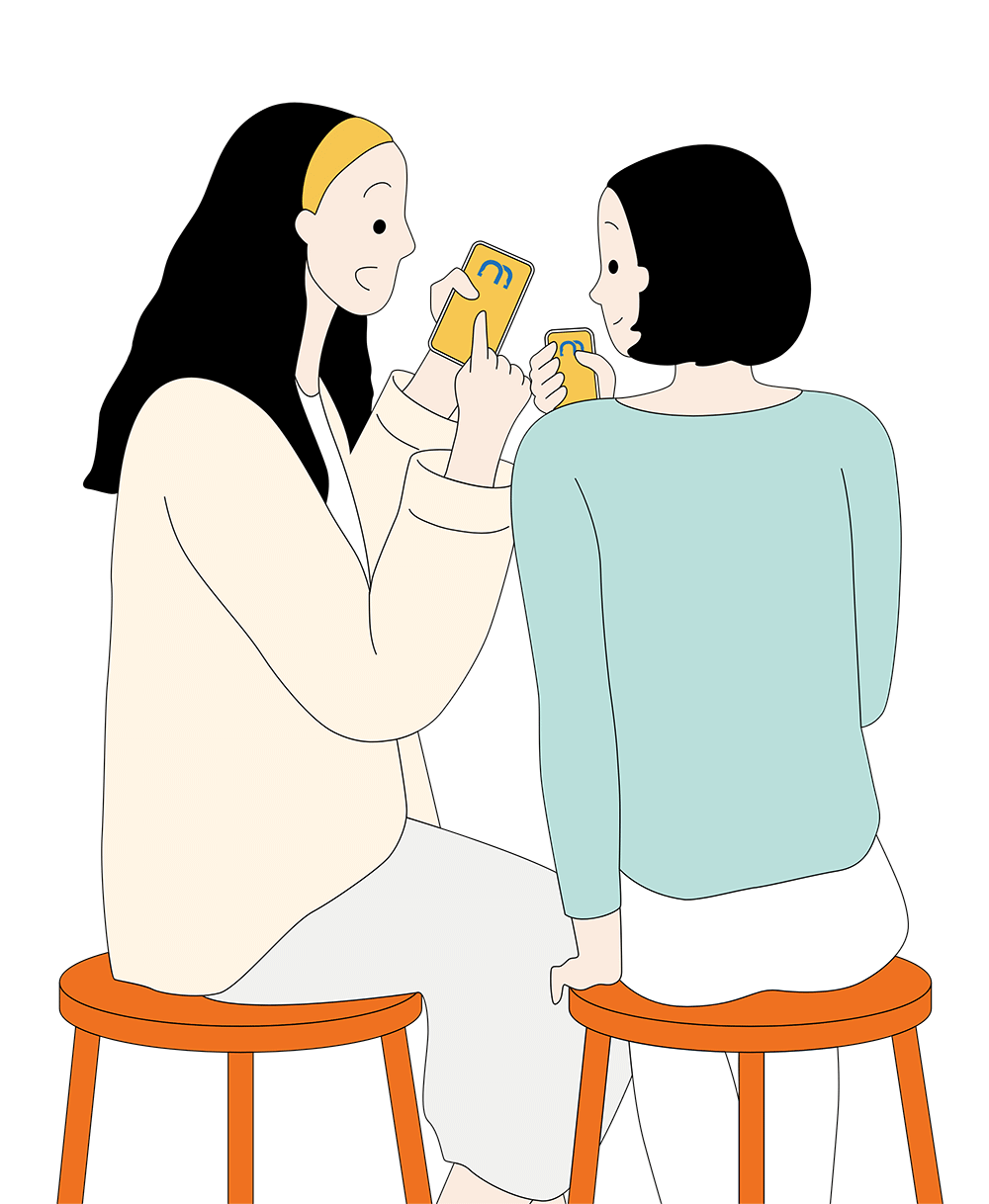
Get 2-week FREE
Chinese Classes
Original Price: ¥600
Get 2 Weeks of FREE Chinese Classes
Original Price: ¥600
